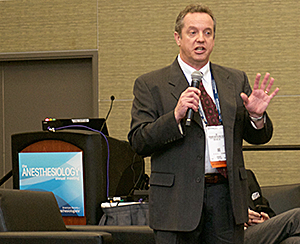
Edward J. Bertaccini, M.D., makes a presentation about a drug that’s similar to propofol.
“Swimming With the Sharks” showcased to a packed audience the medical device or drug products of five anesthesiologist inventors. The first session of its kind at the ANESTHESIOLOGY meeting, the Tuesday session simulated how pharmaceutical and medical devices are developed and brought to market in real life. No winner was selected from the presentations.
First into the tank was Edward J. Bertaccini, M.D., from Stanford University. He presented “investors” with a new drug invention that’s similar to propofol but with a better patient safety profile. Dr. Bertaccini anticipated revenue of $233 million in a six- to seven-year period from his new drug. “Shark” Clive Meanwell, M.D., Ph.D., of The Medicines Company, Inc., in Parsippany, New Jersey, asked: “What is it about your molecular modeling that gives you an edge?” “What would be the return on an investment?” The best answer: 30 percent annualized.
Next up was Sheldon Goldstein, M.D., of Montefiore Medical Center, in Bronx, New York, who presented the Multiple Coagulation Test System (MCTS). It is a medical device that uses theranostic testing to indicate which therapy would restore blood to normal, with the goal of decreasing blood transfusions. “At least 40 percent of blood transfusions are obtained unnecessarily,” said Dr. Goldstein. “Shark” Wendye Robbins, M.D., of Blade Therapeutics, Inc., in San Francisco, wanted Dr. Goldstein to go bigger. “Think about other potential technology you could wrap into this program — not just a single product, but a bigger idea. That’s when investors get excited,” she said.
William Kerns, D.V.M., of Ternus Pharma in Duxbury, Massachusetts showed his propofol pro-drug development, which promises to immediately convert to propofol upon injection, but doesn’t confer pain at the injection site and remains stable for at least 48 hours. “Shark” Pamela P. Palmer, M.D., Ph.D., of AcelRx Pharmaceutical, in Redwood City, California, liked the idea but said that Dr. Kerns needs to prove that it doesn’t cause pain at the injection site. “If you’re going to fail, fail quick and fail cheaply,” she said.
David Kaczka, M.D., Ph.D., from the University of Iowa Hospital and Clinics in Iowa City, presented his product, multifrequency ventilation. The technology delivers ventilation in various frequencies to different regions of the lung. It has the potential to reduce the risk of acute respiratory distress syndrome, which results in 74,000 deaths annually. Dr. Kaczka projected that if his product is successful, a one-time buyout is likely. “Shark” Palmer didn’t like the sound of that. “The plan for a buyout as an exit strategy is what you want. But investors can smell that a mile away. If you don’t have the money to move your product along, you’re chum in the water. Always act like you have enough money to go to the next step.”
Finally, Neil P. Ray, M.D., with the University of California, Davis, Medical Center, presented the Raydiant Oximetry, which can piggyback on existing fetal monitors to increase the accuracy of detecting fetal distress. It holds the promise of reducing the need for C-section, which is the most common surgery performed in the U.S. “We often think babies are in distress when they aren’t,” Dr. Ray said. His product uses non-invasive transabdominal fetal oximetry to assess a baby’s oxygen saturation by shining a light on the mother’s abdomen. “A baby’s oxygen saturation indicates whether the baby is truly in distress with 99 percent accuracy,” Dr. Ray said. The sharks wondered: Does it work on mothers who are obese?
Overall, “Swimming with the Sharks” was a big hit. Participants and would-be entrepreneurs learned a lot about product entrepreneurship from this entertaining and informative exercise, which was created in honor of the late Theodore Henry Stanley, M.D. He was an anesthesiologist with the University of Utah and a medical entrepreneur, who, with a colleague, invented the fentanyl lollipop to treat cancer pain.
Return to Archive Index